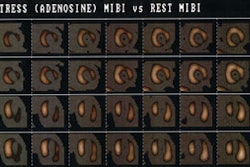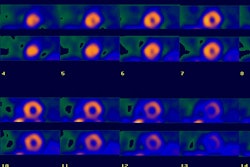J Nucl Med 1995 Jun;36(6):956-61
Myocardial sympathetic nervous dysfunction detected with iodine-123-MIBG is
associated with low heart rate variability after myocardial infarction.
Mantysaari M, Kuikka J, Hartikainen J, Mustonen J, Mussalo H, Tahvanainen K,
Lansimies E, Uusitupa M, Pyorala K.
The association between myocardial sympathetic innervation and heart rate
variability after myocardial infarction was studied in a group of 12 men (aged
30-65 yr) 3 mo after their first myocardial infarction. METHODS: Viable
myocardium was imaged using 123I-phenylpentadecanoic acid (pPPA). Functioning
myocardial sympathetic nervous tissue was imaged using
[123I]-metaiodobenzylguanidine (MIBG). Heart rate variability was measured as
the ratio of maximum-to-minimum RR intervals in ECG during deep breathing.
RESULTS: The patients were divided into normal (n = 6) and low (n = 6) heart
rate variability groups. Myocardial infarction size (pPPA defect) was comparable
in the normal and low heart rate variability groups. Even the MIBG defect size
was not significantly different in the normal and low groups, the portion of
viable myocardium with impaired sympathetic innervation (MIBG defect minus pPPA
defect) was significantly greater in the low heart rate variability group than
in the normal group. CONCLUSION: The extent of viable myocardium with disturbed
sympathetic innervation was greater in patients with low heart rate variability
as compared to those with normal heart rate variability 3 mo after myocardial
infarction.



